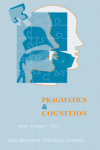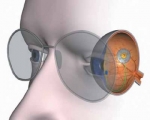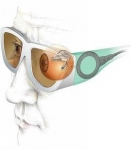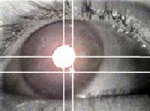Apr 25, 2006
Transcranial direct current stimulation
From New Scientist
It sounds like quackery, but it's not. A growing body of evidence suggests that passing a small electric current through your head can have a profound effect on the way your brain works. Called transcranial direct current stimulation (tDCS), the technique has already been shown to boost verbal and motor skills and to improve learning and memory in healthy people - making fully-functioning brains work even better. It is also showing promise as a therapy to cure migraine ...
Read the full article
23:20 Posted in Research tools | Permalink | Comments (0) | Tags: Positive Technology
Neuroelectronics
Via Mind Hacks

The New Atlantis has a comprehensive article on 'neuroelectronics' - the science of interfacing digital components with neural wetware. From the article:
The potential merging of mind and machine thrills, frightens, and intrigues us. For decades, experiments at the border between brains and electronics have led to sensationalistic media coverage, vivid science fiction portrayals, and dreams of cyborgs and bionic men. But recently, this area of science has seen remarkable advances—from robotic limbs controlled directly by brain activity, to brain implants that alter the mood of the depressed, to rats steered by remote control. Adam Keiper explores the peculiar history and present directions of this research, and considers the challenges of staying human in the age of neuroelectronics.
23:11 Posted in Neurotechnology & neuroinformatics | Permalink | Comments (0) | Tags: Positive Technology
Takeluma sonic alphabet

[pcho.net & pcho.net (avi, 13mb)]
23:02 Posted in Cyberart | Permalink | Comments (0) | Tags: Positive Technology
Games for Health Day
Davidson Executive Conference Center 3415 South Figueroa Street :: Los Angeles, California 90089
The Games for Health Project, Robert Wood Johnson Foundation, TATRC, and USC’s Annenberg School for Communication & Institute for Creative Technologies invite you to join us on May 9 for a full-day event devoted to the use of games and game technologies in health and healthcare, including an evening reception.
This one-day event, just before the opening of the Electronic Entertainment Expo will bring together researchers, game developers, and health & healthcare professionals for a series of talks devoted to how games and game technologies are addressing critical health & healthcare issues.
Talks will focus on:
• Health messaging using games
• Combat & emergency medicine
• Psychotherapy and Post Traumatic Stress Disorder
• Pain Distraction & Anxiety
• Cancer treatment
• Disease management
• Coping with family ailments
• Cognitive health
• Off-the-Shelf consumer health & exergaming titles
22:57 Posted in Positive Technology events | Permalink | Comments (0) | Tags: Positive Technology
Humanlike robots
Via the Presence Listserv
 Japan boasts the most advanced humanoid robots in the world, represented by Honda's Asimo and other bipedal machines. They are expected to eventually pitch in as the workforce shrinks amid the dwindling and aging population. But why build a robot with pigmented silicone skin, smooth gestures and even makeup? To Repliee's creator, Hiroshi Ishiguro, the answer is simple: "Android science."
Japan boasts the most advanced humanoid robots in the world, represented by Honda's Asimo and other bipedal machines. They are expected to eventually pitch in as the workforce shrinks amid the dwindling and aging population. But why build a robot with pigmented silicone skin, smooth gestures and even makeup? To Repliee's creator, Hiroshi Ishiguro, the answer is simple: "Android science."
Read the full story from Scientific American
22:45 Posted in AI & robotics | Permalink | Comments (0) | Tags: Positive Technology
Apr 22, 2006
Neuromarketing: Brain Fitness Concept Challenged
13:07 Posted in Brain training & cognitive enhancement | Permalink | Comments (0) | Tags: Positive Technology
A website that predicts your thoughts
From Cognitive Daily
There is a website that claims to predict with 98 percent accuracy what site visitors would be thinking after a short quiz.
I tried the game and it worked!
Then I looked for other mind-readers, and I found several versions:
there is even a website that offers different Flash-based customizations of the mind reader
12:47 Posted in Cyberart | Permalink | Comments (0) | Tags: Positive Technology
Apr 21, 2006
The mood of your blog
Via Smart Mobs (New Scientist)
New Scientist has an article about a software called MoodViews that tracks mood swings across the 'blogosphere' and pinpoints the events behind them. Moodviews was created by Gilad Mishne and colleagues at Amsterdam University, The Netherlands. At present, MoodViews consists of three components, each offering a different view of global mood levels, the aggregate across all postings of the various moods:
- Moodgrapher tracks the global mood levels,
- Moodteller predicts them, and
- Moodsignals helps in understanding the underlying reasons for mood changes.

From the MoodViews website:
"Check out the impact of global events on global moods. Find out whether it is true that people drink more during the weekend. Observe states-of-mind with a cyclic nature; e.g., people feel energetic in the mornings and relaxed in the evening"
19:10 Posted in Emotional computing | Permalink | Comments (0) | Tags: Positive Technology
Workshop on the Cognitive Science of Games and Game play
As part of CogSci 2006, 26-29 July 2006, Montreal, Canada
From the website
Craig Lindley: Cognitive Science of Games and Gameplay (full day)
Cognitive science has always had a strong relationship with games and game play. Simple cognition tests frequently having the form of games, and games like chess have provided traditional models of intense cognitive challenges. Ongoing advances in computer game technology have supported the creation of commercial games presenting a wide variety of cognitive challenges embedded within rich, engaging audiovisual worlds. The growth of computer games as an entertainment technology and medium is having a major cultural and social impact, with game players frequently spending large portions of their discretional time deeply immersed in game play.
Despite the emergence of computer games as a major cultural and economic force, the scientific study of complex games is in its very early stages. Methodologies and theoretical paradigms are still being established, and the world waits for substantial results before game systems can be more fully deployed across broad application areas. Games are fundamentally learning systems and this is of particular interest, both from the perspective of the cognitive changes in players arising from entertainment gameplay (and their attendant social implications) and from the perspective of how games might function in more specific pedagogical and therapeutic contexts.
Theories and methods from cognitive science appear to be among the most promising for studying the structure, dynamics, affects and effects of games and game play. Moreover, computer games provide rich, multi-modal, but still controllable environments for conducting cognitive experiments having potentially higher ecological validity than the rarefied experiments of traditional cognitive psychology.
This workshop aims to bring together cognitive scientists interested in game phenomena, cognitive scientists interested in using games as a research tool, game researchers interested in cognitive approaches to the study of games, and game researchers interested in games for the study of cognition. The aim is to consolidate and focus these interests in a new field of the Cognitive Science of Games and Game Play. Topics of interest include but are not limited to:
- cognition-based theoretical frameworks for the study of games and gameplay
- games as a methodological tool for cognition research
- emotion and aesthetics of games and game engagement
- cognitive neurophysiology of games and play
- cognitive foundations of game design principles
- cognitive and perceptual substructure of game interaction
- effects of game play upon player cognitive processes
- schemata involved in game play
- player modelling and motivational factors
- computational modelling of players, play processes, tactics, strategies and learning
- game interaction as a basis of cognitive modelling
- perceptual loading, attention and cognitive capacity management in game play
- empirical study of games, methods, results and interpretations
- social cognition and multiplayer games
- the cognitive substructure of fun
The workshop will be held from 0830 to 1700 on Wednesday July 26 2006.
Submission
Those interested in attending the workshop should submit a 500 – 1000 word abstract by 19 May 2006. Submissions should be sent in electronic form to: craig.lindley@hgo.se Authors of accepted abstracts should submit full papers by Friday 30 June 2006. Full papers may be up to 10 A4 pages in length.
19:00 Posted in Call for papers | Permalink | Comments (0) | Tags: Positive Technology
Electronic media causing ADHD?
From Mind Hacks
Neuroscientist Baroness Greenfield was featured on Radio 4's Today Programme this morning [realaudio] arguing that children are being medicated for ADHD when the problem might be caused by the over-use of 'electronic media' leading to short attention spans...
read the full post
18:05 Posted in Persuasive technology | Permalink | Comments (0) | Tags: Positive Technology
Ageing, Impairment, and Technology
Forthcoming special issues of Pragmatics & Cognition

Editors: Pim Haselager, Maria Eunice Qumlice Gonzales, and Itiel Dror
Deadline for submissions: 30 June 2006
Publication: Summer 2007
2. Ageing, Impairment, and Technology (call for papers)
Editors: Romola Bucks, Jonathan Cole, and Itiel Dror
Deadline for submissions: 30 June 2007
Publication: Summer 2008
Editors: Boris Velichkovsky and Itiel Dror
Deadline for submissions: 30 June 2008
Publication: Summer 2009
6. Cognitive Development and Education in the Mirror of Technology (call for papers)
Editors: TBA and Itiel Dror
Deadline for submissions: 30 June 2009
Publication: Summer 2010
16:25 Posted in Call for papers | Permalink | Comments (0) | Tags: Positive Technology
Intelligent Medical Implants Reports Artificial Vision Breakthrough
"The provoked visual perceptions were pleasant, according to the patients, and this was the first time they had seen something in many years-- in one case, several decades. Understandably, they reacted emotionally to their visual experience."
Hans-Juergen Tiedtke
Chief Executive Officer
IIP-Technologies GmbH
IIP-Technologies GmbH, on behalf of its parent company Intelligent Medical Implants AG ("IMI") (www.intmedimplants.com), announced today that a limited clinical study related to its ongoing Early Human Trial has demonstrated that IMI's patented, first-generation Learning Retinal Implant(TM) enabled patients to see light - as well as simple patterns - via a wireless transmission of data and energy. This is the first time in the history of the development of artificial vision that completely wireless transmission of data and energy into an implant in the eye of long-time blind persons has resulted in pattern recognition.
 The Learning Retinal Implant has been successfully implanted in four patients for a duration of up to 13 weeks to date (the first implantation occurred in late-November 2005). Subsequent clinical testing of the IMI device with these patients commenced on schedule beginning in January 2006 at the University of Hamburg (Germany) Medical School under principal investigator Prof. Gisbert Richard, Professor of Ophthalmology. Each of the implantations has been "extremely well-tolerated" and fixation of the implant has been "stable, with no inflammatory reactions," according to Prof. Richard.
The Learning Retinal Implant has been successfully implanted in four patients for a duration of up to 13 weeks to date (the first implantation occurred in late-November 2005). Subsequent clinical testing of the IMI device with these patients commenced on schedule beginning in January 2006 at the University of Hamburg (Germany) Medical School under principal investigator Prof. Gisbert Richard, Professor of Ophthalmology. Each of the implantations has been "extremely well-tolerated" and fixation of the implant has been "stable, with no inflammatory reactions," according to Prof. Richard.
"Each of these blind persons had no visual perception at all, yet upon wireless stimulation of the retina via the Learning Retinal Implant, they were able to 'see' something,"said Hans-Juergen Tiedtke, CEO of IIP-Technologies, a subsidiary of IMI. "One patient, for example, a 65-year-old female from Marienberg, Germany, has not had sight for more than a half century. From early childhood she has suffered from RP, meaning that she has not seen normally for more than 60 years. Nevertheless, in her first pattern recognition test, she described continuous objects such as a half circle. There is no doubt that this result is extremely positive, given that she has had no sight for almost her entire life, yet was still able to immediately receive a visual perception from electrical stimulation.

"While further clinical testing is needed and planned, we are truly delighted by these early results. It is our expectation that, in the not-too-distant future, our Learning Retinal Implant System, along with rehabilitation, may allow patients to recognize objects by identifying their size, as well as their position, movements and shapes. In other words, a blind person, using our Learning Retinal Implant System, is expected to be able to move independently in an unfamiliar environment--thus enabling him or her to lead an autonomous life. Indeed, development of a wireless visual prosthesis that could be implanted permanently with good results is the 'Holy Grail' of artificial vision," added Mr. Tiedtke.
IMI's initial clinical-indication focus is blind persons with Retinitis Pigmentosa ('RP'), one of the two most common causes of vision loss in persons over the age of 50 by hereditary degenerative retinal diseases. RP is considered irreversible, and no treatment or cure is known to date. Several million people are affected worldwide.
13:30 Posted in Brain training & cognitive enhancement | Permalink | Comments (0) | Tags: Positive Technology
Apr 20, 2006
Online Communities and Virtual Worlds for Patient and Caregiver Self-Help Groups
Via VRPSYCH mailing list
The Institute of Rural Health at the Idaho State University has announced the following webconferencing session:
Online Communities and Virtual Worlds for Patient and Caregiver Self-Help Groups
Meeting Date and Time: APRIL 20, NOON-1:00 PM MDT (Mountain Daylight Time)
Presenter: John Lester
Online communities offer a unique opportunity for patients and caregivers to share experiences and emotional support with people across the world. John Lester will discuss his experiences with Braintalk Communities (www.braintalk.org), which offers hundreds of forums and chatrooms for self-help support groups focused on a wide range of neurological disorders.
Started in 1993, Braintalk continues to explore new models of online communities and support. John will describe the growth and evolution of Braintalk as well as his work using the 3-d virtual world of Second Life ( www.secondlife.com) to create new online communities supporting people dealing with Asperger's Syndrome, Cerebral Palsy, and Stroke Survivors. He will also summarize how different groups of patients and caregivers can use vastly different communication modalities to help them deal with unique conditions.
John Lester Bio:
===============
John Lester joined Linden Lab (the creators of Second Life) in 2005, bringing experience in online community development as well as a background in the fields of healthcare and education. Previously he was the Information Technology Director in the Neurology Service at Massachusetts General Hospital, where he pioneered the use of the web in 1993 to create online communities for supporting patients dealing with neurological disorders. He also held an academic appointment at Harvard Medical School , where he created online collaborative environments for professors and students to advance the case-based teaching method in medical education. John created and continues to manage BrainTalk Communities, a non-profit organization who's mission is to provide online environments for patient and caregiver self-help groups focused on neurological disorders.
HOW TO JOIN THE WEBCONFERENCE?
-------------------------------------------------------------
Cut and paste the entire link below including the meeting_id in the address text box of your internet browser.
Session Link:
Meeting Date and Time: Apr 20, 2006 NOON to 1:00 PM (MDT)
This conference session is an open one and DOES NOT REQUIRE A PASSWORD. Thus, you only need to enter your name on the sign in page and log in without entering a password.
Please note: If your computer has a microphone and speakers you will be able to talk and hear while you are in the Elluminate session. If you do not have a microphone, you can still interact with your peers and the speaker through text chat.
IMPORTANT
==========
If this is the first time you will be using Elluminate, you may be prompted to download some software which may take anywhere from 2 to 20 minutes depending upon your Internet connection speed. We advise you to get your PC ready to access the webconference a day or two before the scheduled date of the talk. You can pre-configure your system with the required software by going to the support page located at:
http://elm1.elluminate.com/HOSTEDISUIRH/support.html
Elluminate Help Desk Tel Numbers: 866-388-8674 option 2, 703-464-9158
19:35 Posted in Cybertherapy | Permalink | Comments (0) | Tags: Positive Technology
New book about ubicomp
Via Smart Mobs
The Well's Inkwell Conference features a discussion with Adam Greenfield, author of Everyware:
Computing devices shrink ever smaller and become invisible, while at the same time we interact with them and they communicate with one another. Rather than carrying phones and PDAs, our desks, rooms, and clothing, our food and our sex toys converge, interconnect, and interact. Their connectedness is hidden from us, we don't control the information they record, and there's no "Undo" key."Great, another loopy novelist in the Inkwell, extrapolating from a random headline in a trade journal," you say.
It's not loopy fiction, according to Adam Greenfield. Instead, it's the form computing will take in the next few years, and it behooves us to think it through in advance, in order both to understand it and humanize it. That's the subject of "Everyware: The dawning age of ubiquitous computing."
Join Adam Greenfield from the beginning of the conversation or catch up on the latest posts
19:25 Posted in Pervasive computing | Permalink | Comments (0) | Tags: Positive Technology
Neurofeedback can alleviate the symptoms of autism
The technique involves hooking people up to electrodes and getting them to try and control their brain waves. In people with autism, the "mu" wave is thought to be dysfunctional. Since this wave is associated with "mirror neurons" - the brain cells that underpin empathy and understanding of others - Jaime Pineda at the University of California, San Diego, wondered if controlling it through neurofeedback could exercise faulty mirror neurons and improve their function.
He attached sensors to the necks and heads of eight children with autism and had them watch a video game of a racing car going round a track. For all of the children, sitting still and concentrating kept the car travelling around the track, but five of them were also able to harness their mu waves and use them to adjust the car's speed.
After 30 sessions over 10 weeks, Pineda found that the five children's mu brainwaves had changed and they performed better on tasks involving imitation, typically difficult for people with autism.
19:05 Posted in Biofeedback & neurofeedback | Permalink | Comments (0) | Tags: Positive Technology
An android for enhancing social skills and emotion recognition in people with autism
An android for enhancing social skills and emotion recognition in people with autism.
IEEE Trans Neural Syst Rehabil Eng. 2005 Dec;13(4):507-15
Authors: Pioggia G, Igliozzi R, Ferro M, Ahluwalia A, Muratori F, De Rossi D
It is well documented that the processing of social and emotional information is impaired in people with autism. Recent studies have shown that individuals, particularly those with high functioning autism, can learn to cope with common social situations if they are made to enact possible scenarios they may encounter in real life during therapy. The main aim of this work is to describe an interactive life-like facial display (FACE) and a supporting therapeutic protocol that will enable us to verify if the system can help children with autism to learn, identify, interpret, and use emotional information and extend these skills in a socially appropriate, flexible, and adaptive context. The therapeutic setup consists of a specially equipped room in which the subject, under the supervision of a therapist, can interact with FACE. The android display and associated control system has automatic facial tracking, expression recognition, and eye tracking. The treatment scheme is based on a series of therapist-guided sessions in which a patient communicates with FACE through an interactive console. Preliminary data regarding the exposure to FACE of two children are reported.
17:52 Posted in AI & robotics | Permalink | Comments (0) | Tags: Positive Technology
IPRIZE: a $1,000,000 Challenge for Eye-Tracking
Via the IPRIZE website

- EyeTracking.net, Internet resource dedicated to eye movement related research and applications (Systems, Labs & people, Apps & projects, Papers & courses, Events & jobs)
- Eyetracking Papers, John Dylan McCarthy's list of eyetracking research papers on web
- Gaze-Based HCI Bibliography, tutorial bibliography with links to on-line papers
- Eye Tracking Links by the Gaze-Based Interaction Group, University of Tampere
- ECEM, European Conference on Eye Movements [ECEM13 2005] [ECEM12 2003] [ECEM11 2001] [ECEM10 1999]
- ETRA, Eye Tracking Research & Applications Symposium [ETRA 2006] [ETRA 2004] [ETRA 2002] [ETRA 2000]
- VIV, Vision in Vehicles [VIV11 2005] [VIV10 2003] [VIV9 2001]
- BIP 2005, International Workshop on Bioinspired Information Processing: Cognitive modeling and gaze-based communication
- The First Irish Workshop on Eye-Tracking
- Second Finnish Symposium for Eye-movement Research
- Eyes-Tea meetings
11:02 Posted in Research institutions & funding opportunities | Permalink | Comments (0) | Tags: Positive Technology
Apr 18, 2006
2007 Bower Award and Prize for Achievement in Science

The Franklin Institute is soliciting nominations for the 2007 Bower Award and Prize for Achievement in Science, which will be on the theme of Human-Centered Computing
From the website:
The Franklin Institute invites you to nominate candidates for the Benjamin Franklin Medals, the 2007 Bower Award and Prize for Achievement in Science and the 2007 Bower Award for Business Leadership.
The Benjamin Franklin Medals are awarded annually in seven disciplines of science: chemistry, computer and cognitive science, earth and environmental science, electrical engineering, life science, mechanical engineering, and physics.
The Bower Awards are presented in a predetermined field of interest chosen each year. The theme of the 2007 Bower Award for Achievement in Science is Human-Centered Computing. The theme of the 2007 Bower Award for Business Leadership is Computer and Cognitive Science.
Please feel free to share this Call for Nominations with others who might wish to submit a nomination. Questions about the appropriateness of a particular nomination are welcome and should be directed to Dr. Philip W. Hammer, Vice President, The Franklin Institute, at the number and/or address listed in the nomination sections. 2007 nominations must be received in the Awards office by May 31, 2006.
22:52 Posted in Research institutions & funding opportunities | Permalink | Comments (0) | Tags: Positive Technology
Human Technology Special Issue: Culture, Creativity and Technology
Via Usability News
Deadline: 8 May 2006
Advances in interactive computing technology have blurred the line between art, social studies and science. The age of digital reproduction is making radical changes in how art is created, distributed and perceived. Recent work from the humanities and arts has constructively critiqued traditional Interaction Design theory and practice. Studies of experience with technology can provide new insights into the potential of interactivity in contemporary arts and performance, as well as new tools for creativity.
This special issue will provide a forum for radically interdisciplinary analysis of digital technology. It will focus on the role of technology in enhancing culture and creativity. It will seek critical and reflective approaches to the design and analysis of interactive technology. Contributions will be welcomed from the Arts and Humanities as well as the Sciences. Contributions can take the form of academic papers but also less traditional creative presentation formats such as multimedia, digital artwork and sound.
Arts and HCI
Re-mediation
Technology and Experience
Enabling Creativity
Performance Arts
Entertainment and Leisure Identity Politics
Collaborative approaches
Approaches of Interest:
Interaction design, computer science, engineering, architecture, cultural
studies, media studies, literary studies, critical theory, aesthetics,
performance arts, digital art, psychology, socio-technical studies.
21:45 Posted in Call for papers | Permalink | Comments (0) | Tags: Positive Technology
Virtual Reality treatment in post traumatic stress disorder
 In the study, veternas used a head-mounted display and experienced a virtual Vietnam War clip (J. Clin. Psychiatry, in press). To more closely simulate actual combat, each of the veterans stood or sat on a platform above a vibrating speaker during the therapy session. According to Dr. Rothbaum, patients showed consistent improvements.
In the study, veternas used a head-mounted display and experienced a virtual Vietnam War clip (J. Clin. Psychiatry, in press). To more closely simulate actual combat, each of the veterans stood or sat on a platform above a vibrating speaker during the therapy session. According to Dr. Rothbaum, patients showed consistent improvements.Read the full report on Clinical Psychiatry News
21:30 Posted in Cybertherapy | Permalink | Comments (0) | Tags: Positive Technology






